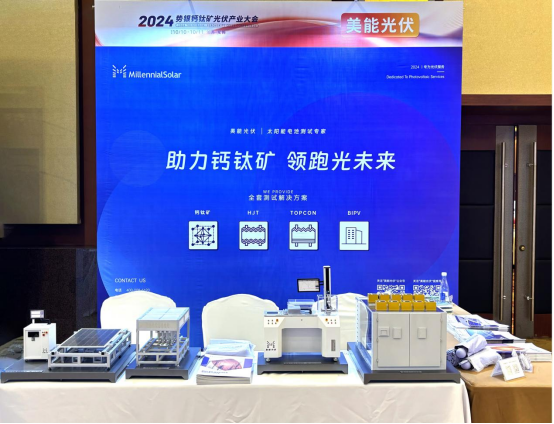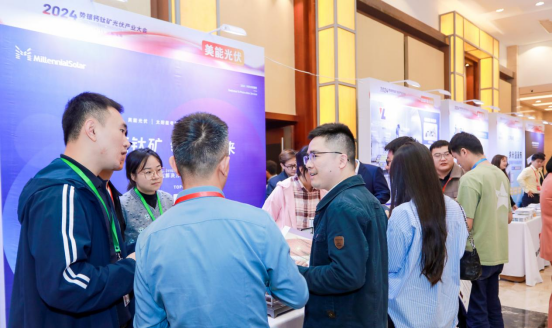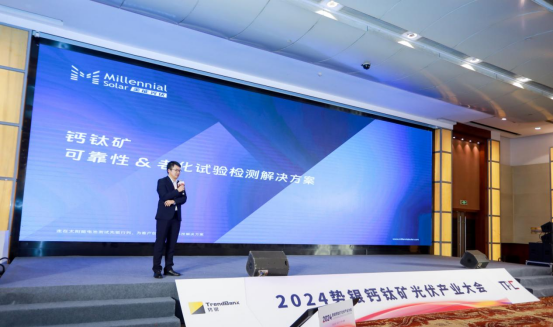
量子效率测试仪
PL/EL一体机
Sinton硅片少子寿命测试仪
Sinton硅块少子寿命测试仪
绒面反射率测试仪
3D共聚焦显微镜
清洗制绒工作站
在线四探针方阻测试仪
全自动扫描四探针方阻测试仪
在线薄膜厚度测试仪
晶化率测试仪
Horiba显微共焦拉曼光谱仪
傅里叶红外光谱仪
霍尔效应测试仪
分光光度计
全光谱椭偏仪
Horiba椭圆偏振光谱仪
TLM接触电阻率测试仪
超景深显微镜
网版智能影像测量仪
全自动影像测量仪
卧式拉力机
电池片稳态光衰老化试验箱
电池片紫外老化试验箱
电池片拉脱力综合测试仪
外观检验台
湿漏电测试系统
组件实验室EL测试仪
紫外老化试验箱
稳态光衰老化试验箱
电流连续性监测系统
PID测试系统
旁路二极管测试系统
LeTID测试系统
反向电流过载系统
脉冲电压测试系统
绝缘耐压测试仪
接地连续性测试仪
绝缘耐压接地测试仪
湿热环境试验箱
湿冻环境试验箱
热循环试验箱
动态机械载荷测试机
静态机械载荷测试机
冰雹冲击试验机
引出端强度试验机
霰弹冲击试验机
抗划伤(切割)测试机
剥离试验机
万能材料试验机(单臂)
万能材料试验机(双臂)
光伏玻璃透过率测试仪
醋酸测试试验箱
交联度测试系统
二极管接线盒综合测试仪
落球冲击试验机
半自动四探针
全自动探针式台阶仪
多通道太阳能MPPT系统
Horiba稳瞬态荧光光谱仪
钙钛矿P1激光划线测试仪
钙钛矿在线膜厚测试仪
钙钛矿工艺检测工作站
手持式IV测试仪
便携式EL测试仪
手持热成像测试仪
户外组件IV测试仪
户外组件多通道测试系统
光伏逆变器电能质量测试仪
无人机EL检测仪
美能光伏携钙钛矿太阳能电池检测方案,亮相无锡势银大会
日期:2024-10-11浏览量:40
光伏行业快速发展的今天,钙钛矿太阳能电池作为新一代光伏技术的代表,正受到全球范围内的广泛关注。2024年10月10日至11日,由势银(TrendBank)主办的“2024势银钙钛矿光伏产业大会”在江苏无锡盛大召开。本次大会汇集了来自全球的光伏行业专家、学者、企业家以及产业链各环节的代表,共同探讨钙钛矿光伏技术的最新进展和未来趋势。

在此次大会上,我司作为参展商之一,给大家带来了钙钛矿太阳能电池检测解决方案,并根据方案提供专业的检测设备:紫外老化试验箱、湿漏电测试系统、量子效率测试仪、多通道太阳能电池MPPT系统等,为钙钛矿太阳能电池的检测提供了全面而精准的解决方案。

美能光伏的展位吸引了众多参会者的目光,展示的设备不仅在技术上领先,更在实际操作中表现出了高稳定性和高效率,充分满足了钙钛矿太阳能电池在检测方面对质量控制的严格要求。这些设备的展出,不仅展示了美能光伏在光伏检测技术方面的专业能力,也体现了公司对推动行业发展和技术创新的承诺。

大会期间,美能光伏的产品经理胡超,关于钙钛矿可靠性以及老化试验检测解决方案,与参会的行业专家进行了深入交流,共同探讨了钙钛矿太阳能电池检测技术的未来发展方向。
美能光伏全面布局钙钛矿/叠层太阳能电池工艺制程控制检测装备,提供高效钙钛矿太阳能电池和组件检测装备,及智能检测分析系统解决方案。
钙钛矿单结与叠层电池工艺制备检测产品推荐:
美能量子效率测试仪
测量原理:用不同波长单色光照射太阳能电池,根据短路电流等因素测量绝对光谱响应和相对光谱响应。
产品优势:双光源、长焦距单色仪,光谱范围广,光斑大且均匀性好,准直性优,可测试多种电池,有多种探针接触模式,针对钙钛矿/Si 叠层电池有偏光/偏压系统。
模块介绍:包括四结电池测试、基本功能(SR/EQE 测试等)和高级功能(可选配)。
美能多通道太阳能电池MPPT系统
产品特点:光源使用寿命长,光斑可定制,光强有多个档位,光源等级高,光谱范围及功率可控,冷却方式为风冷,可自动光照 / 暗态循环。
模块介绍:包括光源模块、夹具模块(控温可 N₂密封)和电子负载模块(高精度)
钙钛矿单结与叠层电池封装可靠性检测产品推荐:
湿漏电测试系统
产品优势:检测钙钛矿组件在潮湿条件下的绝缘性,包括绝缘水槽、控制面板、电导率测试和绝缘耐压测试仪等部分,可提供特定电压的直流电源,测量绝缘电阻,水槽有定制体积和材质,控温系统确保水温恒定。
紫外老化试验箱
产品优势:用于测试钙钛矿组件中高分子材料的性能变化,光谱范围 280 - 400nm,辐照强度 150 - 250W/m²,不均匀性≤13%,有多种配置和监测功能。

随着“2024势银钙钛矿光伏产业大会”的圆满落幕,美能光伏再次证明了其在光伏检测领域的领先地位。公司期待与行业内的伙伴们携手合作,共同迎接光伏产业的光明未来。




































































